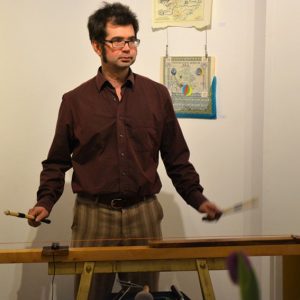
After studying music in Feldkirch, the musician and composer, Martin Gut, studied classical guitar at the Music Academy in Vienna, taking in addition courses in harmonic theory and electro-acoustics. As a composer he is however self-taught. Recalling Geothe’s view that architecture is frozen music, for Gut, the Wachau Valley resonates with music and resounds with the echoes of sounds that have reverberated over centuries.

As he searched through the awe-inspiring repertoire of musical history and the dazzling array of stratergies that characterise New Music, Martin Gut found himself repeatedly drawn to the idea of a monochord from which overtones could teased out and worked on. Historically the monochord is a tromba marina or marine trumpet, which consists of a single string strung over a two metre long resonance chamber. Such instruments are capable of emitting rich sonorous tones and during the Baroque, were often used as a substitute for the trumpet, which being made of rolled metal, was a very expensive.
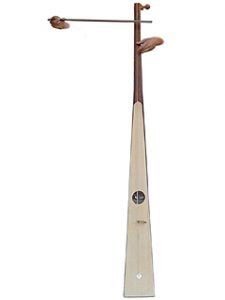
Although Gut can play the tromba marina or Trumscheit as it is known in German, he favours his electric version, which he calls an Electro-Scheit. The process by which he arrived, from classical guitar, to a single string which he generally strikes rather than plucks, was a slow process of filtering out the essences of various kinds of music that was important to him, combined with an interest in the musical-philosophical writings of Plato. Within this range of interests and concerns, the tromba marina repeatedly appeared as something that whilst in its traditional form, was not what he was looking for, in its philosophical and theoretical aspects seemed to be hinting at something.
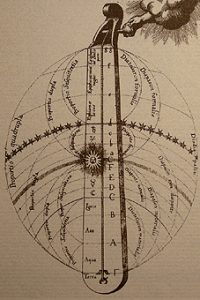
From Robert Fludd, The Divine Monochord, from Macrocosm, 1617/1618
Martin Gut’s musical influences range from John Cage, Karl-Heinz Stockhausen and Derek Bailey, to folk music and Death Metal. It is to this melting pot that his theoretical considerations are then brought to bear. Apart from an interest in the music of the spheres as described by Plato and Kepler (and up-dated by the music theorist Rudolf Haase), other theoretical considerations include an interest in non-classical methods of tuning. In the case of the Electro-Scheidt, by playing both sides of a moveable pick-up head, the musician/composer/inventor is not only able to elicit the hidden overtones but can also modulate them. The result is a series of high-pitched tones that enigmatically meander around an underlying, much deeper pulse of ground tones. Although this often results in some of the music having meditative qualities, this is not always the case and other pieces are more dynamic, with musical tensions being built-up that during the course of a composition are progressively resolved.
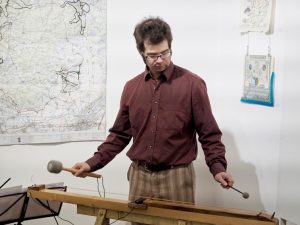
For a white cube style presentation of the „Scheidt“ see brennstein.at/Electroscheidt.
In musical tuning, what is important is that when the notes of a scale are played (regardless of whether in either ascending or descending order), the divisions should represent or intimate a sense of order. Each tone should be distinct from the other and the ratios between tones should leave a space between them that is pure, distinct and uncluttered. Equally there should be enough diversity within a system to allow variation and variety. On reaching the octave or the tonic, there should be the impression of something having been completed. Nevertheless the scale is a theoretical construction and is not a melody in itself. Accordingly the scale should have a certain rigidity to it. This gives structure and invites the invention of melodies that twist, turn and combine to make counterpoints and harmonies. Being a matter of preference, different cultures have different methods or “modes” of tuning which in turn give rise to some notes and combinations of notes being used more than others. At the beginning of the twentieth century, with their so-called “atonal music”, composers initiated a program whose aim was to avoid such structures. By paying equal attention to all the notes of the octave they sought to go beyond the hidden boundaries and confines of traditional “tonal” music. Martin Gut’s Electro-Scheit compositions are however not so much intent on transcending or going beyond boundaries as revealing the repertoire of potential music that is inherent in any note struck. His program is not therefore a modernist program like atonal music but rather is a return back to the beginning, back to the first resonance’s with which music and perhaps the world began.

This return back to the origins of music enables him to “see” and hear the world anew, opening up fresh avenues within more conventional fields of musical expression. In this way Martin Gut’s interest in non-classical methods of tuning music, far from being purely theoretical, is practical and a composition written for guitar to accompany a poem written in Classic Greek by Alexander Curtis uses a tetrachordal system of tuning.
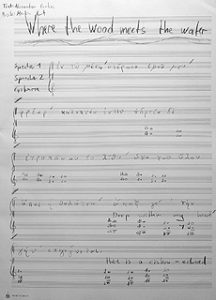
An important vehicle for the finding his way towards his own kind of music is Gut’s ensemble Brennstein in which the composer is joined by Günther Gessert, playing marxophone and theremine and Gabriele Teufner who plays flute and saxophone.

Brennstein’s first CD „Brennstein“, begins with a futurist manifesto in which a radically new architecture of music and space is announced. The typically modernist message of dazzling newness that solves all problems, is however, repeatedly subjected to „technical problems“ which soon enough lead to the promised concert of unrepentant modernity being cancelled. Hesitant and uncertain, notes slowly begin to sound their way out of the embarrassed silence. Step by step, a new form of confidence is won and from the assertive rhythms of the Electro-Scheit, tones and overtones are engendered, followed by melodic fragments, extrapolated by Gabi Teubner and Gunter Gesset. Often taking centre stage, these meander between the hauntingly melodic and the overtly futurist. Not so much pieces stolen from out of the fictive firmament of a futurist heaven, these studies are gleaned from an out-of-orbit planet that, losing its way, has stumbled upon a deeper lying reality that baffles and mesmerises. As announced in the manifesto, a new architecture of sound and space is introduced and yet this is repeatedly interrupted by an anarchist, cabaret style jingle for something that calls itself a „Molatoff Cocktail“ and whose explosive reality is only revealed towards the end of the CD.
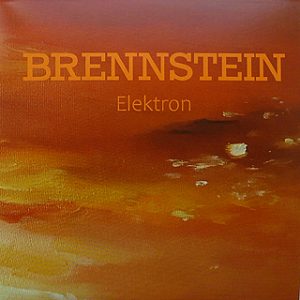
„Brennstein“ is a variation of „Bernstein“ which is the German word for „amber“ and Brennstein’s new CD is entitled „Electron“ which in turn is the Ancient Greek word for amber. As when rubbed, amber generates a static charge, it is from „electron“ that the word „electricity“ derives. After a jaunty love-song, Clear Water, the CD introduces a series of micro-tonal filigrees and poly-rhythmic experiments that are combined with fragmentary phrases that awake fleeting impressions of lost music from a dim and distant past. And yet this is offset by an overriding conviction that this is a music that looks forward to what could be and must be, with past and future being a linked web of tangled threads which Brennstein has miraculously tapped into. In this series of hauntingly beautiful, mesmerising studies, Martin Gut and Brennstein show that a clear focus on formal problems and the working towards solutions thereof, can lead to new ways of thought, feeling and being.

For Martin Theodor Gut the years 2020/2021 mark his coming of age as a composer, with the results being presented at Am Sound 2021, the first of a series of autum concerts organised by Gut and Günter Rable and which has the the Ursula Chapel in Krems as its main venue. At the concert that was dedicated to the music of Martin Theodor Gut, a new piece, zu köstliche Sache, was played by the renowned Koehne Quartett and was greeted with raptous applause. The piece has since been played on Radio Austria’s Ö1 and is now available as a CD along with with other compositions. These are played by the Koehne Quartett (zu köstliche Sache and Versöhnung), the composer and his ensemble, Brennstein (Trio and schleife), the flautist, Sylvie Lacroix (Whistleblower), the pianist, Ines Schuttengruber (Zimmerreise) as well as by the composer alone (K.N.O.T.) In the minimalist schleife, the author Manfred Chobot makes a vocal contribution that alternates with the music of Brennstein, so that music and text point by twists and turns towards a mysterious something that in different ways, the works of Versöhnung all reach out towards and magically succeed in locating. For samples and easy acquisition in Austria and Germany go to: www.preiserrecords.at or www.jpc.de.
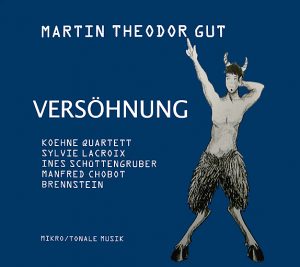
Versöhnung, or „Reconciliation“, is a series of live fields of energy, that are charged by the skilful use of musical structures that awaken impressions of something that is both known and unknown, something that is somehow familar and yet which we also know we are hearing for the first time. Appropriately, the cover shows a satyr and the music, far from being a sentimental return to, or a post-modern re-discovery of Arcady, is instead, the unexpected manifestation of Arcady as a vital force which is there waiting for us should we but listen. Where the opening piece, Trio, is composed using harmonics that derive from the Antique, this is merely the opening for an invigorating series of musical conumdrums that challenge us not only to stop and listen but also to wake up. Following Trio is zu köstliche Sache, with the title being a fragment of a quotation: „Life is such a delectible thing“. This is from Hayden, the father of the string quartett and together with Versöhnung provides unequivocal evidence that what is being heard, is polished and crafted music made by a composer who is part of a tradition in which, for two and a half centuries, music has been written for performance by string quartets. Kunst kommt von können, or „art is born from ability“ and both pieces confirm this, standing up to and holding their own against the vast weight of a potentially over-powering tradition. Between the two pieces there are excursions into other realms. In Whistleblower the flute is put through its paces in a meandering series of scales and arabesques with the percussive properties of the instrument also being exploited with the results being analogous to when string players pluck their instruments. In the minimal K.N.O.T., notes are staged so as to fill out space and time in a way that allows them to be themselves. Although there is a structure to the piece, its subtle sophistication is such that it is not immediately identifiable. In the quartett, Vesöhnung, the composer exploits the possibilities offered by multi-phonics in which notes can be played so as to generate a number of different overtones that are heard simultaneously. To this effect, towards the end of the piece the cello is marginalised and silenced, with its later return enabling a reconcilation with the multi-phonics which orginally lead to its being ostracised. This paves the way for the triumphantly euphoric, Zimmerreise, in which the piano and the tradition of piano music is celebrated.
Departing from the tradition of what has gone before, the two quartett pieces and the piano piece nevertheless all return to it, enabling its creator to look the masters of the past in the eye, no longer looking up, no longer looking down but seeing them as equals in a search for something that each age must re-define for itself. In a time of crisis this might seem the least relevant of our concerns and yet it is not. It is proof that European traditions can be continued, expanded upon and adapted to meet the challenges of the present – so that through change and adaption, Europe might have a genuine future. Here however it is necessary to add that although art is born from ability, this does not mean that either art or music are purely formal games in which there is no message and in which content is irrelevant, for what Martin Gut achieves in Versöhnung is achieved through his having a wider vision that encompasses and forms his musical vision – which however, all the while is open to prompting’s and suggestions that arise through the formal aspects of the musical systems with which the composer works with. Thus the modernist architectural maxim „form follows function“ can be exposed as a facile dogma, for while form may often follow function, it can also prompt new ways of interacting with things and thus give rise to new functions and new ways of seeing the world and how we are to live in it and it is precisely this is the achievement of Versöhnung.
Gut still plays overtone music his Scheit. Now fitted with two strings, the influences of his chamber music compositions over the last few years flow into his performances resulting in a more complex sonic environment than before. For those in search of the connection between Martin Gut’s monochord music and his first two string quartetts, the missing link is provided by Waking Up…Trembling (for my wife) which was composed in 2022 and premiered at Am Sound 2022 in the Ursula Chapel. A string quartett played by the Koehne Quartett, this meditative and atmospheric piece is challenging and demanding for musicians to play and continues in a more substantial format, some of the concerns begun by Gut in his monochord compositions. The title refers to the feeling of an electric charge on the skin that is sometimes felt on waking up. In the piece, Gut was, to paraphrase rather than translate, „on the one hand concerned with rigourously following through a musical idea, on the other he was aiming at a form of listening-in in which one forgets oneself“. This arose and was enabled by, an artist in residence program in Lithuania in which the composer was able to completely devote himself to the composition without the continual stream of outside influences that constitute daily life.

